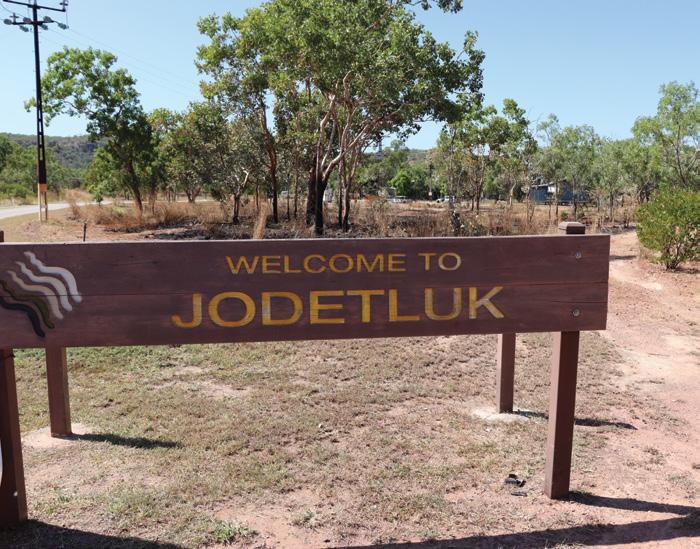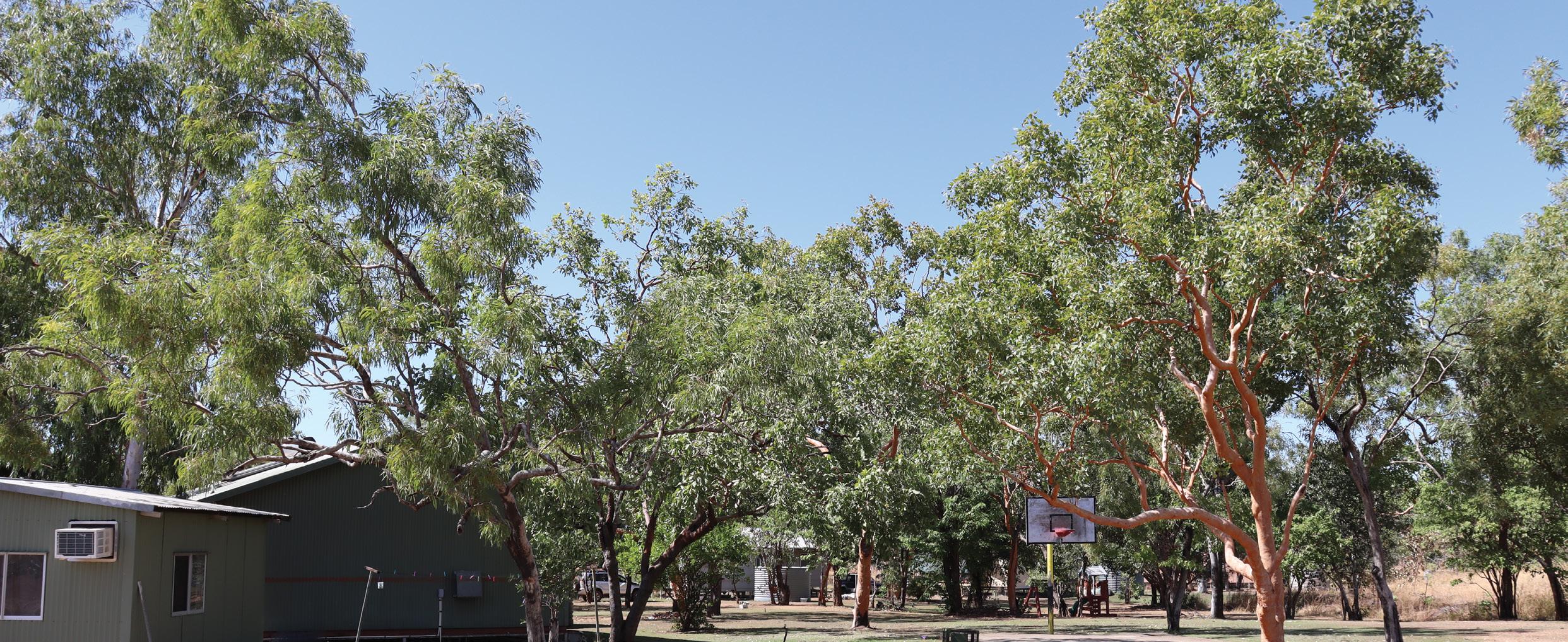
7 minute read
IMPROVING THE QUALITY OF LIFE FOR REMOTE HOMELAND COMMUNITIES
from Council Winter 2022
by Monkey Media
Jodetluk outstation, which will be receiving new solar street lights as part of the Homeland Project.
Roper Gulf Regional Council is a remote local government located in the Northern Territory, overseeing a land mass nearly three times the size of Tasmania and home to eleven remote outstations (or homelands), three of which will be upgraded with new solar powered infrastructure and water tanks, thanks to support from Council and funding from the National Indigenous Australians Agency (NIAA).
Those who have not lived in the Northern Territory before may have never heard of a remote outstation or be able to imagine what one would look like.
An outstation, or homeland, is a small, remote satellite community of a larger Indigenous Australian community, composed of Indigenous people who have chosen to take up residence on that land due to its cultural and spiritual significance.
Outstations are rich in culture and provide significant value to Indigenous Australian life in the region and the Northern Territory as a whole.
These remote communities are not without their challenges, and that’s why the Roper Gulf Regional Council, in partnership with the Northern Land Council, scoped the work that needed to be done at these outstations, and applied for funding from the National Indigenous Australians Agency (NIAA) through its Aboriginal Benefit Account (ABA) Homelands Project.
Their application was successful, with the region being awarded a total of $1,123,583 through the Homelands Project to go towards improving the living conditions of these remote outstations.
Roper Gulf Regional Council Chief Executive Officer, Marc Gardner, outlined the importance of outstations as part of Council’s operations.
“These places are very significant for people to maintain cultural ties to their land and home, and important for maintaining a good quality of life,” Mr Gardner said.
“Residents value an ability to live, work and play in areas where their families have lived and belonged to for generations.”
LIFE IN THE OUTSTATIONS
Within the Roper Gulf region, there are approximately 300 people living across the eleven outstations that the Council services, with the largest outstation population being approximately 60 people.
These figures are approximate due to the transient nature of these locations and the seasonal variations that occur due to wet weather restricted access. That said, it is not only extreme weather conditions that bring challenges to the residents of outstations.
The Roper Gulf Regional Council local government area spans 201,000km2 – almost three times the size of Tasmania – making its operational footprint one of the largest in the Northern Territory.
Within this area are just 16 remote townships and communities, and eleven remote outstations, with a total population of 7,458.
The remoteness of the area means that common living benefits that are afforded to the rest of Australia are not available for people that live in these locations.
Access to electricity from the main power grid is not available to outstations, thus requiring residents to run critical electrical appliances with power sourced from diesel-powered electrical generators. There can be anywhere between five and fifteen houses running off one generator.
Fresh water is sometimes sourced from nearby springs where bore water or town water cannot be sourced, however the water being pumped from the spring is at risk of contamination, or can dry up due to the lack of rain during the dry season.
Spring water is often pumped through a diesel-powered generator as well. If the generator breaks down, residents may have to walk for kilometres in extreme heat to the nearest boundary fence where the spring is located, to
source fresh water for drinking, cooking and bathing.
Furthermore, running a diesel engine generator has substantial financial and environmental costs for those who reside in outstations.
These challenges are the reason the Homelands Project is crucial for the community, and essential to improve the quality of life for those who reside in the outstations.
Roper Gulf Regional Council has been granted funding through the Homelands Project and will use these funds to carry out works in Kewulyi, Mount Catt and Jodetluk – three remote outstations that sit within the Roper Gulf region.
The projects for each outstation and the benefits are as follows:
KEWULYI HOMELAND: ∞ Supply and install a new solar hybrid system ∞ Supply and install a water tank
MOUNT CATT HOMELAND: ∞ Supply and install a new solar hybrid system ∞ Drill a new bore and install a water tank
JODETLUK HOMELAND ∞ Supply and install solar street lights
Entrance to Jodetluk outstation.
PRACTICAL SOLUTIONS FOR THE REGION
The installation of a new solar hybrid system in Kewulyi and Mount Catt will mean that residents no longer need to rely on electricity supplied by a diesel-powered generator, avoiding the risk of the generator breaking down or being overloaded.
Moving to a solar hybrid system will also reduce the costs associated with running a diesel-powered generator, making more funding available for other projects to be carried out in the community.
In addition to the installation of the solar hybrid systems, water tanks will also be supplied and installed at both Kewulyi and Mount Catt.
The water at Kewulyi is currently being pumped from a nearby spring, which often dries up in dry season weather conditions. When the spring dries up, the water level becomes low and the quality of the water decreases, sometimes producing brown, dirty water. The Northern Territory’s dry season runs from May to October, potentially leaving a whole community without clean water, or water altogether, for half the year.
Similarly to Kewulyi, the water at Mount Catt is also pumped from a local spring at the boundary of the outstation. Whilst this spring is permanent and has year round access to water, it requires a diesel engine pump to transport water to the houses.
This pump needs to be started several times a day at the spring, however in contrast to Kewulyi, which has issues in the dry season, the wet season conditions make the track to the Mount Catt spring too wet for vehicle access, and residents may be required to walk to the spring for clean water.
The installation of new water tanks will allow the outstations to store fresh water next to the dwellings for all-year-round access to high quality water supplies. The water tanks will be raised on stands to increase the water pressure running into the community reticulation – to ensure all houses can run water simultaneously.
The project in Jodetluk will involve installing two solar street lights to provide lighting to unlit areas where residents walk and children play. Community consultation will occur with homeland residents to select the best location for the street lights.
The purpose of this project, in addition to increasing the energy efficiency of the homeland, is to improve community safety.
This project is part of a Crime Prevention Through Environmental Design (CPTED) strategy which lobbies for appropriate technologies and techniques, such as LD solar lights, as a crime prevention method. The solar lights will benefit the community by decreasing black spots and enabling passive surveillance of the streets and houses.
Not only that, the street lights will deter buffalos, snakes and other wild animals from wandering through the homeland dwellings – another unique problem the Roper Gulf region faces.
BUILDING A SUSTAINABLE, VIBRANT REGION FOR ALL
These projects carried out as a result of the Aboriginal Benefit Account Homelands Project funding are instrumental to improving the overall quality of life of local people, and that of the community as a whole.
Roper Gulf Regional Council is grateful to the Federal Government for providing funding that assists Council in achieving its vision of being sustainable, viable and vibrant.
Mr Gardner said that, “Council looks forward to supporting and improving the quality of life for everyone that lives at a homeland or an outstation and understands their value to residents in our Council area.
“It’s for these reasons that our Council is behind providing a range of quality outstation and homelands services such as housing, water provision and waste solutions.”
Council would also like to thank the Northern Territory Government’s Department of the Chief Minister and Cabinet, and the Northern Land Council, who it works in partnership with to improve the living conditions for outstations in the local government area.

Outstations provide significant value to Indigenous Australian life in the Northern Territory.











